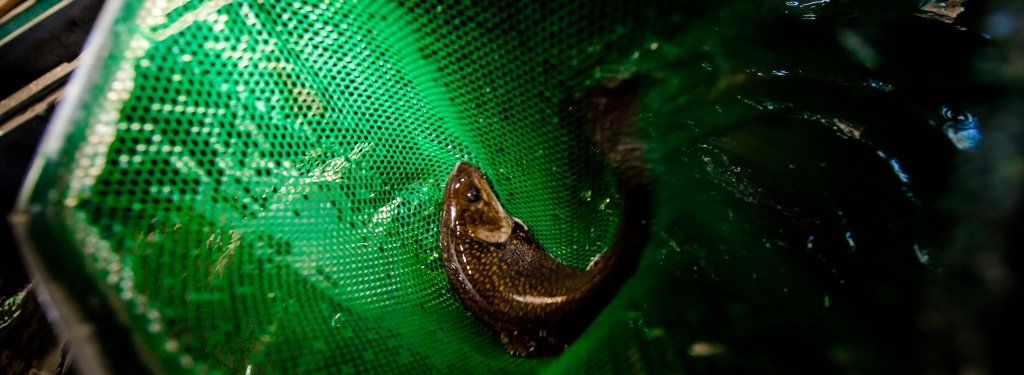Fishing isn't just for dads. Report finds young female anglers on the rise.
Recent research proves the stereotype that fishing is a “dad sport” is no longer accurate. Building on earlier research that found the number of people who fish has been steadily declining, a new study conducted by researchers at Michigan Technological University and funded by the Great Lakes Fishery Commission, evaluates the shifting demographics within the angling community and determine how the changing composition may impact fishery management decisions.
Among the major findings, is that female fishers make up a growing proportion of anglers in the Great Lakes region, as younger generations of women are more likely to fish than their mothers and grandmothers. The increasing number of female anglers in the younger angling community, however, is not sufficient to reverse the overall decline in anglers.
Each year, approximately 1.8 million recreational anglers fish the Great Lakes. Millions more fish inland lakes and streams across the Upper Great Lakes region. Anglers play a critical role in the region’s fisheries, their related ecosystems and fisheries management's practices and policies.
Richelle Winkler, associate professor of sociology and demography and the principal investigator for the study, with doctoral student Erin Burkett, examined changes to the angling population by looking at the recent trends in anglers through various demographic lenses, such as gender, age, time period and birth cohort. The researchers looked broadly at the total population of all anglers in the upper Great Lakes states (Illinois, Indiana, Michigan, Minnesota and Wisconsin), as well as a subset of those anglers who specifically fish salmon and trout in the Great Lakes.
Coming of Age
A key finding was that while the stereotype that most of the people who fish are older (born before 1965) is true, the stereotype that fishing is a man’s sport, does not hold true in younger generations.
On the contrary, the research found that in the younger angler community (those born after 1980), males are less likely to fish than their predecessors, and females are more likely to fish than prior generations. The only exception is that in states that offer a spousal fishing license, older generation females (born in the late 1950s and 1960s) also show high participation rates, in correspondence with a male spouse.

This means that as the current angling community ages and is increasingly replaced by newer generations, the number of male anglers is projected to decline and the number of female anglers is projected to remain stable or increase over the next fifteen years. It is important to note, however, that the increase in female anglers will not be sufficient to supplant the overall decline in anglers.
“If these patterns of change in composition of the Great Lakes angling community continue, they could have significant implications for agency funding, habitat programs and development and implementation of fisheries management strategies,” Winkler says.
Previous research by Winkler projected more dramatic declines in the population of hunters in Wisconsin and Michigan. Winkler emphasized the importance of conducting population projections for these two groups saying, “Because hunters and anglers together provide the majority of state fish and wildlife funding programs and represent the most active stakeholder groups, the combined impact of hunter and angler decline and cohort replacement could be substantial for state fish and wildlife agencies.”
Shifting Tactics
As the angler population becomes increasingly female, managers and policy-makers will have to consider how to engage female anglers more actively as constituents and decision-makers, Winkler says. Recruitment, retention and reactivation programs (known as R3), might focus on retaining the relatively large number of young women who are now fishing through their adulthood; for example, through a targeted marketing program or by facilitating opportunities for women to continue to participate as they take on careers and become mothers.

"Women tend to put their own recreational interests on the back burner when family and work demands increase, so it will be important to find ways to help women manage that burden if they are to continue to fish through their life," added Winkler. She says additional efforts should focus on methods for engaging more diverse stakeholders in fishers, "beyond the anglers, as the number of future anglers is likely to decline.”
In looking at salmon and trout anglers of the Upper Great Lakes, the study did not investigate differences in gender composition within this subset of the angling community. It did conclude there were analogous generational trends to the broader community in two of the three Great Lakes studied. Older generations of salmon and trout anglers were significantly more likely to participate than newer generations in both Lake Huron and Lake Michigan. In Lake Superior, however, there was no clear distinction between generations.
Looking towards the future, the salmon and trout angler populations are projected to decline in Lake Huron and Lake Michigan, while Lake Superior populations are expected to remain stable. This trend could be indicative of the quality of the fishery, which has declined in recent years due to decreasing alewife populations, or it may be more related to the past condition of the fishery when Lake Huron and Lake Michigan provided abundant salmon fishing opportunities at the time when the Baby Boom generation came of age and started fishing. This opportunity might have come at just the right time to create a stronger cohort effect in these lakes than what we see in Lake Superior, which didn’t experience the same proliferation of Pacific salmon.
Implications for Fisheries Management
Great Lakes Fishery Commission chair Jim McKane reiterated the importance of this research and applauded Winkler’s approach to evaluating the implications these findings may have for fishery management in the future.
“The Great Lakes region supports a $7 billion fishery," McKane says. "To manage this important resource in a proper and comprehensive way, fishery managers need to know their audience and appreciate who their stakeholders are. Research, such as this study, is critical to informing the development and implementation of policies and strategies that are meant to maximize the value of the fishery and people’s ability to use it.”
More information about this project, including reports and maps for each state and lake, as well as access to all demographic data collected as part of this study, can be found on the report website.
This article is a joint release between the Great Lakes Fishery Commission and Michigan Tech. Jill Wingfield is communications and policy program manager at the Commission.
Michigan Technological University is an R1 public research university founded in 1885 in Houghton, and is home to nearly 7,500 students from more than 60 countries around the world. Consistently ranked among the best universities in the country for return on investment, Michigan's flagship technological university offers more than 185 undergraduate and graduate degree programs in science and technology, engineering, computing, forestry, business, health professions, humanities, mathematics, social sciences, and the arts. The rural campus is situated just miles from Lake Superior in Michigan's Upper Peninsula, offering year-round opportunities for outdoor adventure.






Comments